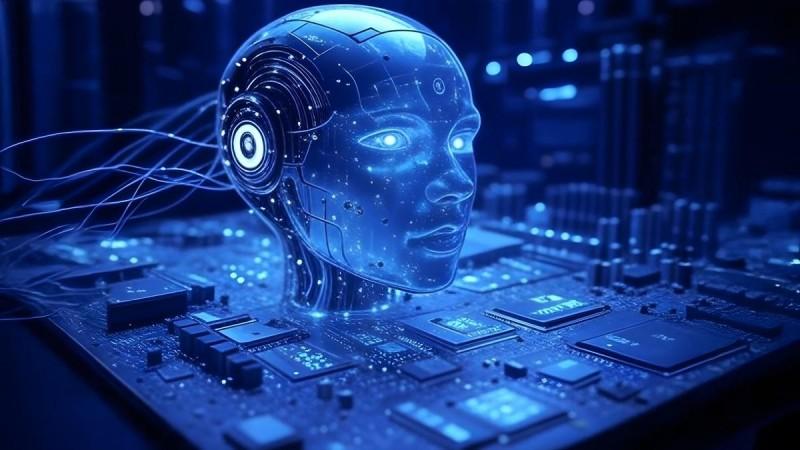
The latest CrowdStrike Global Threat Report (2025) has issued a stark warning: the next generation of cyberattacks is not being written by humans but by machines that learn, adapt, and deceive. Artificial Intelligence, the same force driving digital innovation, is now powering cybercrime at an unprecedented scale. For India poised on the threshold of a $5 trillion digital economy this is no longer a risk on the horizon. It is a clear and present danger.
The report shows that India has witnessed a 75% surge in AI-driven cyber intrusions within a year. Deepfakes, cloned voices, self-mutating malware, and autonomous phishing bots have become tools of choice for adversaries ranging from global syndicates to state-sponsored entities.
"AI has flattened the learning curve for cybercriminals. It has industrialized deception." — George Kurtz, CEO, CrowdStrike
India's digital economy built on data highways, fintech rails, and AI-driven governance now faces a paradox: the very technology that enables growth also threatens to destabilize it.
1. The Dual-Edge of Intelligence
India's transformation into a digital-first economy has been one of the fastest in the world. Over 1.4 billion citizens are digitally connected; UPI transactions exceed $2 trillion annually; and government services increasingly depend on cloud and AI platforms.
Yet, this velocity of transformation has outpaced the country's collective cyber readiness.
AI has altered the nature of both defense and offense in cyberspace. It enables enterprises to detect anomalies faster but it also empowers attackers to bypass them even faster. In essence, the battlefield has become algorithmic. The war is no longer human versus machine; it is machine versus machine, with human trust as collateral damage.
"In the age of machine-speed attacks, resilience not impenetrability is the true measure of security." — Dr. Tobias Feakin, Australian Cyber Ambassador
2. Corporate India: The New Frontline
Indian corporates are facing an unprecedented convergence of technology, compliance, and governance risks.
A joint PwC–DSCI 2024 survey revealed that only 38% of Indian enterprises have AI-enabled cybersecurity frameworks, and less than half of corporate boards discuss cyber risk quarterly.
This gap is alarming because cyber risk has become existential. A single breach can disrupt supply chains, paralyze payment systems, or compromise millions of consumer identities. The financial sector, which anchors India's digital economy, has become a prime target: AI-powered scams now mimic authentic voice commands, execute transactions through deepfake authorizations, and penetrate authentication layers.
"Cybercrime is no longer an IT problem it's an enterprise survival problem." — Nandan Nilekani, Chair, Infosys & UIDAI Architect
The transition from compliance-based protection to strategic cyber resilience remains India Inc.'s unfinished agenda.
3. Economic Cost of Insecurity
The World Economic Forum's Global Risks Report 2025 ranks AI-enabled cyberattacks among the top three threats to emerging economies.
According to IBM's Cost of Data Breach Report 2024, Indian firms lost an average of ₹17.5 crore per breach, with incident resolution times exceeding 290 days. The indirect costs brand erosion, regulatory fines, investor distrust are often multiples of the direct financial loss.
A KPMG forecast (2025) warns that unchecked AI-driven cybercrime could shave off 1% of India's GDP by 2030, effectively stalling its $5 trillion ambition.
Cyber incidents also distort macroeconomic indicators: they increase insurance premiums, deter FDI inflows, and impose new compliance costs. Each attack not only compromises a firm but erodes systemic trust the invisible currency of a digital economy.
"The invisible cost of cyber insecurity is lost confidence, and once confidence erodes, growth follows." — Christine Lagarde, President, European Central Bank
4. When the Machine Turns Against the Market
Generative AI has turned cybercrime into a scalable business model. Deepfake videos impersonating CEOs have tricked financial officers into transferring millions. AI-written malware rewrites itself mid-attack. Autonomous "red teams" simulate human behavior to evade machine learning detection.
These developments blur the lines between fraud, espionage, and economic warfare. In an interconnected economy, one compromised enterprise can trigger cascading failures across supply networks, logistics chains, and financial markets.
India's own Digital Public Infrastructure (DPI) a marvel of inclusion and efficiency has become a high-value target for algorithmic adversaries. While Aadhaar, UPI, and DigiLocker have revolutionized service delivery, their interconnectedness means that a single breach could have systemic consequences.
"Every nation's GDP now has a cyber GDP embedded within it. Disrupt that, and you disrupt the nation." — Dr. Latha Reddy, Former Deputy NSA, India
5. Boardrooms Under Siege
Globally, the U.S. SEC's 2023 cybersecurity rule and the EU's NIS2 Directive have made boards legally accountable for material cyber incidents. India's Digital Personal Data Protection Act (DPDP) has taken an important step forward, but corporate governance must evolve from delegation to direct oversight.
Cybersecurity is now a fiduciary responsibility. Boards must demand real-time threat dashboards, not annual audits. Risk committees must integrate cyber resilience KPIs alongside financial metrics. And directors themselves must acquire cyber literacy understanding how data flows, how AI models are trained, and where vulnerabilities lie.
"Cybersecurity governance begins with informed directors. The tone at the top defines the resilience at the bottom." — Rama Vedashree, Former CEO, Data Security Council of India
6. The Strategic Convergence: Economic Security Meets National Security
The blurring of civil and military domains is perhaps the most defining feature of 21st-century conflict. Cyberattacks on power grids, satellites, logistics systems, and financial exchanges can paralyze nations without a single shot fired.
For India, whose defence modernization increasingly depends on AI, autonomous systems, and networked warfare, AI-driven cyber aggression is both a strategic and sovereignty concern.
China's State Council white paper (2024) openly emphasized "algorithmic advantage" as a component of national competitiveness. Western powers, too, are expanding AI-led cyber commands under integrated deterrence doctrines.
India's National Cyber Security Strategy, awaiting cabinet approval since 2021, must now urgently be AI-updated integrating defence, intelligence, and private-sector nodes into a unified resilience grid.
"The next war will not begin with a missile launch but with a machine-learning exploit." — Gen. Paul Nakasone, Former Commander, U.S. Cyber Command
7. Building the Architecture of Digital Trust
Securing India's economic future demands a national cyber-resilience architecture multi-layered, adaptive, and intelligence-driven.
This architecture must rest on five pillars:
- AI versus AI: Deploying autonomous, learning systems for threat detection and predictive defence.
- Zero Trust Principles: Verifying every access, every transaction, every packet.
- Public-Private Fusion: Real-time intelligence sharing between industry and government.
- Capacity Building: Training cyber professionals at scale India needs at least 1 million skilled cyber defenders by 2030.
- International Collaboration: Active participation in global cyber norms, deterrence frameworks, and joint attribution protocols.
The government's initiatives Digital India 2.0, IndiaAI Mission, and the Cyber Surakshit Bharat programme provide a foundation. Yet, the pace and scope must expand exponentially to match the speed of threat evolution.
"Digital trust will be the competitive advantage of nations in the AI century." — Brad Smith, Vice Chair & President, Microsoft
8. From Reactive to Predictive Leadership
AI-driven cybercrime represents a new class of systemic risk unpredictable, borderless, and compounding. Traditional reactive postures are obsolete.
Leaders corporate, bureaucratic, and political must now think in predictive horizons, integrating cyber foresight into every strategy document, investment plan, and national policy.
This transition requires a mindset shift: treating cybersecurity not as a sunk cost but as a strategic investment in continuity, reputation, and national power.
Boardrooms must internalize that AI safety is business safety, and policymakers must recognize that digital sovereignty is the new economic independence.
"In an AI world, the strongest currency is not capital, but control over cognition." - Yuval Noah Harari, Historian and Thinker
The Road Ahead: Securing the $5 Trillion Vision
India's aspiration to reach a $5 trillion GDP is inseparable from its digital economy, projected to contribute over $1 trillion by 2030.
But this ambition will remain fragile unless cyber resilience becomes a national mission integrated into infrastructure, education, finance, and defence.
The policy imperative is clear:
Establish a National Cyber Resilience Authority with cross-sectoral jurisdiction.
Mandate AI safety audits for critical systems and fintech operations.
Create a Cyber Defence Innovation Fund to support startups developing indigenous AI-security tools.
Embed cyber literacy into education and governance training systems.
"If India can secure its digital arteries, it will not just be a $5 trillion economy it will be a trusted digital power."- Dr. V. Anantha Nageswaran, Chief Economic Adviser, Government of India
From Digital Expansion to Digital Sovereignty
AI-driven cybercrime is not merely a technological challenge it is a civilizational test of how societies govern intelligence itself.
For India, this moment demands a shift from digital expansion to digital sovereignty, from speed to security, and from adoption to anticipation.
The 21st-century economy will belong not to the nation with the fastest algorithms, but to the one with the safest intelligence.
If India must rise as a global power in the AI century, it must first master the art of defending its digital destiny.
[Major General Dr Dilawar Singh is an Indian Army veteran who has led the Indian Army's Financial Management, training and research divisions introducing numerous initiatives therein. He is the Senior Vice President of the Global Economist Forum AO ECOSOC, United Nations and The Co President of the Global Development Bank.]












